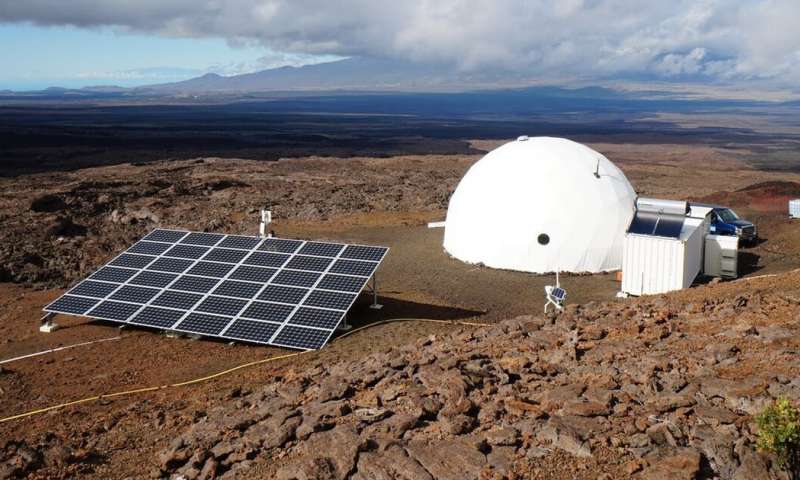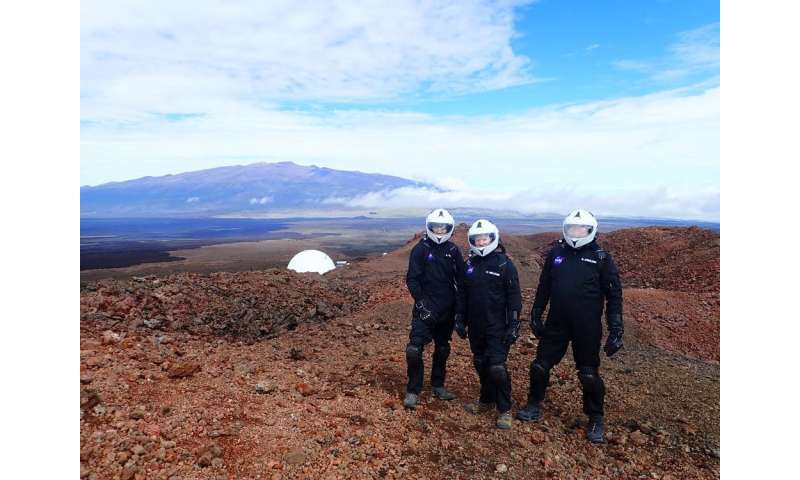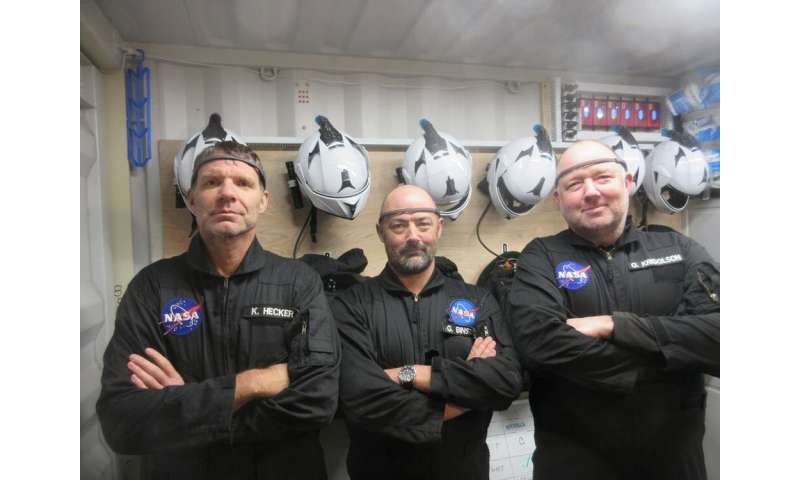 |
| The Hawaii Space Exploration Analog and Simulation (HI-SEAS) is a research facility designed to simulate conditions on Mars. Credit: Olave Krigolson |
A journey to Mars is not going to be easy and there are a number of problems that need to be solved before we go. One interesting problem is how do we monitor the astronauts themselves. Of course, it is easy to monitor their heart rate and blood pressure, but is it possible to monitor what is going on inside their heads?
A recent all-Canadian neuroscience research team spent seven days in the Mars Habitat (the Hab) at the Hawaii Space Exploration Analog and Simulation (HI-SEAS) on a simulated mission trying to tackle that exact problem—developing a capability to monitor brain health and performance in real time.
Using mobile electroencephalography (EEG) to measure brain waves, we were able to successfully monitor five different aspects of cognitive brain function: perception, attention, memory, learning and decision-making. We were also able to observe deficits in brain function brought about by stress, depression and cognitive fatigue.
As the principle investigator of the Theoretical and Applied Neuroscience Laboratory at the University of Victoria, I lead a research team of graduate students, undergraduate students and research assistants. Two of my Ph.D. students took part in the Mars project—Chad Williams and Tom Ferguson—along with two of my colleagues from other universities, experimental psychologist Gordon Binsted and statistics expert Kent Hecker.
Studying tiredness
On our Mars mission at HI-SEAS, our goal was to track cognitive fatigue. Physical fatigue is when our muscles get sore and we experience a lack of energy. Cognitive fatigue is the mental analogue of that: when our brain gets tired and we begin to have deficits in neural function.
 |
| At the Mars habitat, the environment and behaviours were controlled to simulate as much as possible the Mars environment. Credit: Olave Krigolson |
It has been clear for some time now that people make more errors and there is reduced brain activity when one is experiencing cognitive fatigue. The problem with cognitive fatigue is simple—how do we monitor it?
The current standard is to rely on self report which is clearly inadequate. In certain situations the person being asked about their current state of cognitive fatigue might simply not be aware of it. For example, one could imagine a professional athlete who is mentally tired not acknowledging their fatigue so they could continue to play or a surgeon operating when they are too tired to do so. In both instances, the person in question could make a crucial mistake due to cognitive fatigue that could cost the game, or worse.
Using mobile EEG technology we developed a brain-based test that provides a full assessment of brain health and performance. Our test relies on event-related brain potentials (ERPs), which are the brain's responses to something happening. To study the brain's ERPs, we have people play video games and we use mobile EEG to measure the brain's responses to events in these games. Importantly, the algorithms we have developed combine these ERP responses to provide a direct view of brain function so we can quantify stress, depression, cognitive fatigue and a range of other neural states.
Simulated mission
To test the validity of our approach, we undertook a seven day simulated Mars mission in the HI-SEAS habitat. The people at HI-SEAS take these simulations seriously: we were only allowed to leave the Hab in space suits while breathing air that was pumped into our helmets from our backpack life support systems. We only ate freeze dried food. Our communications with the outside world were delayed by 20 minutes to simulate the transmission time from Mars. And despite having to exercise for more than two hours a day, we had eight minutes of total shower time for the week.
To make the simulation even more realistic, our day was structured to mirror what life would be like during a mission on Mars. Each morning started with breakfast and a crew meeting to review the goals set for the day. Activities during the day depended on whether you were assigned to go on an extra-vehicular activity (EVA) or do tasks within the Hab. On EVAs, we explored the surrounding geology, in particular that lava tubes that were all around the Hab. If you stayed inside the Hab, you would exercise, prepare meals and work on research projects. Each day ended with mission reports describing what we had accomplished and what we planned to do the next day.
 |
| The researchers wearing the Muse headsets used to measure cognitive fatigue. Credit: Olave Krigolson |
Intermixed with our daily routine, we tested ourselves with our brain health and performance assessment. For this project, we used the Muse mobile EEG headband, a commercially available EEG headset. Before our Mars project began, we compared the Muse against a medical research grade EEG system and were able to show that the Muse was sufficient to measure a good quality EEG signal.
We also worked with Suva Technologies to develop PEER—an iOS application that measured the ERP data that we needed to perform our brain health and performance assessment. One of the cool things about the technology that we have developed is that the full assessment takes about five minutes from start to finish.
Quick health measurements
Our research project in the Mars habitat was a complete success—we were able to measure our cognitive fatigue levels. We saw clear increases in cognitive fatigue across each day—to be expected after a 16-hour work day. However, although we were only in the Hab for a week, we also saw an increase in cognitive fatigue across the seven days.
We can measure astronaut brain health and performance in less than five minutes using mobile EEG technology, PEER and the algorithms we have developed. And we've found other applications for our technology: we can measure concussions during sporting events, examine cognitive fatigue in industrial and medical environments, predict athlete performance in sport and, most recently, track the progression of mild cognitive impairment into Alzheimer's disease and dementia.
Olave Krigolson
Source News
No comments:
Post a Comment
Note: Only a member of this blog may post a comment.